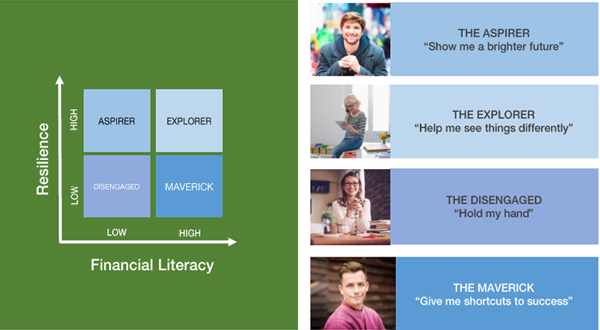This article explores a new framework to help you understand your customers and their needs on a much deeper level.
The industry as a whole often categorise investors by their life-stages.We see them as wealth accumulators, consolidators or protectors, which is typically aligned with the person’s age (or generation) and the stage they are at in their career. Are they a retiring baby boomer nearing retirement? Are they in the 30-something age bracket and trying to accumulate more wealth?
This life-stage model has been heavily relied upon, as it provides professionals in the wealth management industry with a good guide to their clients' product needs. For example, a client nearing retirement is likely to be less reliant on risk products, but could easily require estate planning services.
But does this life-stage segmentation model really provide us enough information about our clients? Do we find out enough to deliver them the best results?
Probably not. So the industry overlays the use of other tools such as risk-profiling and other customer profiling questions to better understand clients and their needs.
At Netwealth, we worked with one of Australia’s leading ethnographic research and brand strategy agencies, The Lab, to find a new way to understand the advice and investment needs of wealth management clients. We developed a customer profiling framework which we feel could really help the wealth industry to easily profile consumers, so it can better categorise the wealth needs of Australians. We’ve named it the ‘Resilience and Literacy Customer Needs Framework’ or ‘RLF’ for short. The RLF divides Australians into four different types of consumer segments based on their financial literacy and their resilience.
Download the guide now to get a deeper understanding of this new customer framework
The framework is defined by two elements:
1. Financial literacy

Financial literacy refers to one’s ability to understand financial products and structures and to determine which of those are most appropriate for their own needs. It is something that is learned through personal experience and education (formal or otherwise), and thus it is not determined by generation or life-stage.
As an example, in Australia, 67 per cent of survey respondents indicated that they understood the concept of compound interest, yet when they were asked to solve a problem using the concept only 28 per cent had enough knowledge of the concept to successfully do so*.
Unfortunately, a large proportion of Australians currently sit at the low-literacy end of the spectrum because they:
- have never been taught about wealth management;
- don’t have the time to learn about wealth management;
- don’t have the inclination to learn; or
- have been taught but never have had the experience.
Interestingly, this remains true regardless of how intelligent or successful an individual is in their other pursuits!
How financially literate are your prospects or existing clients?
2. Resilience

The resilience dimension of the RLF is around one's ability to set long term goals in the face of possible short term failure.
One financial adviser we interviewed during our research with The Lab described resilience: “Overcoming failure takes courage and courage ultimately breeds success.”
Another respondent added, “You need to set yourself long term goals to reap the rewards of your investments.”
It is important to note that a person’s resilience can change with time based on their experiences (and perhaps some good financial coaching). So an investor can begin with low resilience at the beginning of their 'wealth journey', and may witness or experience results that inspire or convince them to believe in longer term strategies, ultimately developing a higher level of resilience.
Guide on Understanding Investors Better
Learn more about the Resilience & Financial Literacy framework
Getting to know the four customer segments
When we add the two dimensions of the RLF together, we end up with four consumer segments, with very distinct investment goals and signifiers of success.
- The Aspirer – with low financial literacy but high resilience;
- The Explorer – with both high financial literacy and resilience;
- The Disengaged – with both low financial literacy and resilience;
- The Maverick – with high financial literacy, but low resilience.
We believe the most interesting segments are the top two segments, Aspirers and Explorers, as they are characterised with higher resilience, that is, a longer term focus which typically means they will make for better financial advice clients.
As a generalisation, most advisers will struggle to on-board and maintain relationships with clients in the Disengaged segment. Typically, they won’t see as much value in the financial advice process and will have more trouble sticking with a long term strategy.
And as for the Maverick segment, we recommend that you steer clear of them. These clients are the ones looking to ‘get rich, quick’. They’re into high risk strategies with short term gains, and they’re always on the lookout for the next ‘big thing’.
Implementing this framework in your business
Which segments do your existing clients fall into? Is there a gap between where you current customer base sits, and where the prospects you would like to work with fit in?
Combined with a traditional risk profile, this method of customer segmentation can easily be incorporated into your advice practice so that you can better understand your clients’ education, communication, engagement and investment needs, ultimately providing you with a tool to help you to create tailored advice offers customised for each individual’s goals.
Are you ready to look into your database to determine which of your clients are Aspirers, Explorers, Disengaged, or Maverick? We have prepared a comprehensive eBook to help you determine where your clients and prospects fit, and how to develop an advice proposition that truly suits their needs.

